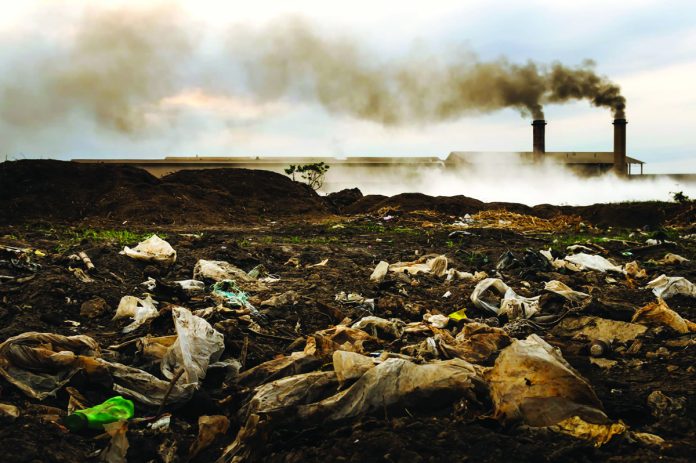Dr. Uzma Shujaat
Pollution remains a persistent and harmful consequence of economic progress, especially in developing nations like Pakistan. With rapid industrialization across Asia, countries are grappling with polluted air, contaminated water sources, waste mismanagement, and increasingly unpredictable weather patterns. Economic activities significantly impact Earth’s systems, affecting the atmosphere faster than any other sphere due to its mixing properties. Additionally, human-driven land-use change ssuch as deforestation, urbanization, and agricultural expansion exacerbate environmental issues and are challenging to quantify at a global level, as their impacts are cumulative across local ecosystems.
One of the most concerning trends in Asia is the Asian Brown Cloud, a dense smog layer that forms each winter. Driven by emissions from vehicles, factories, and forest fires, this haze spans regions from Pakistan to China, reducing sunlight by up to 15% and causing severe respiratory issues, agricultural impacts, and possibly altering regional climate patterns with increased droughts and floods. Despite mitigation efforts, this haze now poses health risks to over two billion people, disrupting agriculture and intensifying regional weather extremes. In 2024, Pakistan’s climate vulnerability continues to be underscored by extreme weather events. According to the World Bank, Pakistan is experiencing warming rates higher than the global average, with an anticipated temperature rise of 1.3°C to 4.9°C by the 2090s, relative to historical baselines. This warming exacerbates urban heat, stresses water resources, and intensifies droughts and floods, impacting food security and public health. According to a research conducted by the World Bank Group (WBG) and the Asian Development Bank (ADB), over five million people may face flooding by 2035-2044, primarily from increased river floods.
Cumulative environmental degradation is another growing concern globally and locally. Over the past decade, attention to cumulative effects especially regarding climate change has intensified among scientists, policymakers, and environmental advocates. Key environmental issues in Pakistan include air and water pollution, hazardous waste, soil degradation, deforestation, and climate vulnerabilities. Climate change remains a pressing threat, directly impacting Pakistan’s agriculture, water resources, and urban sustainability. The frequency and intensity of extreme weather events, including floods and heat waves, have risen, with severe flooding events projected to increase the number of affected individuals by five million by 2035.
Air pollution is a pressing concern in Pakistan’s urban centers, with cities like Karachi, Lahore, and Islamabad consistently recording particulate matter (PM) levels exceeding World Health Organization standards by two to four times. Emissions from fossil fuels, along with industrial pollutants, contribute significantly to respiratory and cardiovascular diseases. Monitoring efforts are limited, covering only six major cities, which hampers the development of a comprehensive air quality strategy. Heavy metals such as lead, primarily from industrial emissions, also contribute to the health risks in urban areas
Deforestation in Pakistan, part of a broader global pattern observed by NASA and the Global Precipitation Measurement mission, disrupts carbon storage and rainfall patterns. This loss of forest cover not only affects Pakistan’s climate resilience but also leads to unpredictable monsoon patterns that threaten agricultural productivity, especially in regions dependent on consistent rainfall. Such environmental pressures underline the vulnerability of Pakistan’s agricultural sector in the face of climate variability Pakistan’s water scarcity problem has intensified. Water availability per capita dropped below 900 cubic meters in 2024, pushing the nation further into “water-scarce” status. According to a report of the United States Institute of Peace, the agricultural sector, responsible for 90% of water usage, is vulnerable due to low storage capacity and inefficient irrigation. In addition, approximately 5.7 million hectares of arable land are affected by salinity, as reported in recent assessments.
This growing issue stems from poor irrigation practices and secondary salinization from saline groundwater use. According to the IAEA, the impact of salinization on crop productivity is severe, causing fields to lose fertility and turn barren, thus posing a significant threat to food security. The situation worsens as Pakistan’s groundwater management faces challenges in balancing agricultural needs with the limitations of water quality and availability. Moreover, water logging continues to exacerbate agricultural challenges, especially in Punjab and Sindh, where an estimated 20% of farmland suffers from high water tables due to extensive surface water use. Urbanization has surged, with approximately 40.1% of Pakistan’s population now residing in urban areas, contributing to environmental degradation through the contamination of water sources with untreated waste. This trend has resulted in increased health issues among urban populations, particularly among low-income communities exposed to polluted water sources
In response to these environmental challenges, Pakistan has been making strides since beginning, though not satisfactory but are still encouraging. In 1992, Pakistan initiated the Forest Sector Master Plan to establish a comprehensive framework for managing and expanding forest resources, which has since served as a baseline for various assessments, including the National Forest and Range Resources Assessment Study (NFRRAS). Conducted in collaboration with national and international organizations, the NFRRAS continues to provide insights into deforestation trends, aiming to curb the loss of forest cover. As of recent reports, Pakistan’s forest cover remains critically low, around 4-5% of total land area, with continued pressures from deforestation and land-use changes
Pakistan’s National Action Plan for Forest and Landscape Restoration, a collaboration with the FAO, has further strengthened efforts by focusing on sustainable forest management and ecosystem conservation, aligning national policies with international standards. These efforts demonstrate Pakistan’s continued commitment to environmental improvement amid challenges posed by climate change and resource limitations. It established the Ministry of Climate Change on August 4, 2017, which oversees national climate policies. Following the ratification of the Paris Agreement in 2016, Pakistan developed Nationally Determined Contributions (NDCs) to reduce emissions and adapt to climate change. However, the primary focus remains on adaptation rather than mitigation due to Pakistan’s vulnerability to climate impacts. The country has introduced initiatives aimed at enhancing water storage, irrigation efficiency, and conservation. There has been observed another push from the government for afforestation under the “Ten Billion Tree Tsunami” initiative in 2019, to improve air quality, reduce deforestation, and enhance bio-diversity resilience.
Under its updated Nationally Determined Contributions (NDCs), Pakistan has pledged to cut emissions by 50% by 2030, with international assistance as a prerequisite. The government also aims to shift 60% of its energy mix to re-newables and promote electric vehicle adoption through supportive policies and foreign partnerships. Strategic investments in renewable energy, advanced water infrastructure, and sustainable farming are critical for reducing climate vulnerability. Alongside these efforts, public engagement and awareness campaigns will encourage water conservation and waste management, especially in urban settings. Realizing these ambitions requires a coordinated approach among government, private entities, and global partners to secure a climate-resilient future for Pakistan.
In 2024, the Recharge Pakistan program emphasizes ecosystem restoration and flood resilience, addressing Pakistan’s vulnerability to frequent monsoon floods and glacial melt in the north. The Ministry of Climate Change plays a key role in coordinating climate initiatives, but effective inter-provincial collaboration remains essential given the decentralized nature of environmental governance.
Pakistan actively engages in global climate forums like the UN Climate Change Conference and has joined the Global Methane Pledge, signaling its commitment to climate mitigation. However, closing the gap between policy and action requires substantial financial backing, with the government advocating for increased climate finance from developed countries to support both mitigation and adaptation efforts.
To tackle these challenges, strong local governance and international cooperation are critical. Pakistan’s strategy could include district-level environmental management plans, empowering local authorities, and establishing sustainable development funds. On the global front, equitable climate action is essential, with monitoring to ensure fair contributions from all nations in combating climate change. This comprehensive approach, combining national reforms and international collaboration, is crucial for Pakistan to manage the social, economic, and environmental impacts of climate change effectively.
The author is the Acting Director of the Area Study Centre for Europe, University of Karachi.







